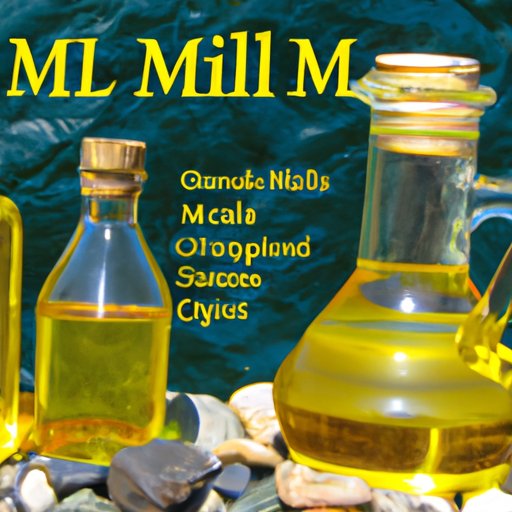Introduction
Mineral oil is a clear, colorless, odorless oil derived from petroleum. It has many uses due to its lubricating properties, and is commonly found in a variety of products including cosmetics, pharmaceuticals, and industrial lubricants. This article will explore what mineral oil is made from, how it is produced, and the potential benefits and risks associated with its use.

Exploring the Properties and Uses of Mineral Oil
Mineral oil is a versatile product that can be used for a range of purposes. It is primarily used as a lubricant and can be found in a number of everyday items such as car engines, air conditioning units, and even bicycles. It is also used in a variety of cosmetic and pharmaceutical products, including skin creams and makeup, as well as being used in the manufacturing of plastics.
How Is Mineral Oil Made?
Mineral oil is made through a series of processes, beginning with the extraction of crude oil from the ground. This crude oil is then processed and refined to create different types of petroleum products, such as gasoline and diesel fuel. The remaining material is then further processed to create mineral oil.
The process of refining mineral oil involves a series of steps. First, the crude oil is heated so that the heavier hydrocarbons separate out. This process is known as fractional distillation. The resulting product is then treated with chemicals to remove any impurities and to improve its clarity. Finally, the product is filtered and further refined to create the final product.
A Comprehensive Guide to Mineral Oil Production
In order to ensure the quality of mineral oil, there are strict regulations governing its production. All companies producing mineral oil must adhere to these regulations, which include testing the oil for contaminants and ensuring that it meets certain specifications. The production process must also be carefully monitored to ensure that all safety standards are met.
Once the oil has been produced, it is packaged and sold to consumers. Companies producing mineral oil must adhere to strict labeling requirements in order to inform consumers about the product’s composition and potential risks. Additionally, companies must provide detailed information on the production process and the health and safety precautions taken during production.

Understanding the Chemical Composition of Mineral Oil
Mineral oil is composed of several different compounds, including hydrocarbons, paraffins, and naphthenes. These compounds interact with each other in various ways, creating a unique chemical makeup. The hydrocarbons give mineral oil its lubricating properties, while the paraffins and naphthenes help to stabilize the oil and reduce its volatility.
The chemical composition of mineral oil can vary depending on the source. Some sources may contain higher levels of hydrocarbons, while others may have more paraffins and naphthenes. It is important to understand the composition of mineral oil before using it, as this will determine its effectiveness and safety.
The Sources of Mineral Oil: What Are They?
Mineral oil can be sourced from a variety of locations, including natural gas wells, oil fields, and coal mines. Each source has its own pros and cons, and it is important to understand the differences between them before choosing a source. Natural gas wells are the most common source of mineral oil, as they are easier to access and produce a high-quality oil. However, they are also expensive and difficult to maintain.
Oil fields and coal mines are less expensive and easier to maintain, but they can produce an oil of lower quality. Additionally, these sources are not renewable and can be environmentally damaging. For this reason, it is important to consider the environmental impact of each source when choosing a mineral oil supplier.

Examining the Benefits of Mineral Oil
Mineral oil has a number of advantages over other oils, including its low cost, high viscosity, and low volatility. Its high viscosity makes it ideal for use in lubrication, as it does not break down easily. It is also non-flammable, making it safer to use in certain applications. Additionally, mineral oil is non-toxic and biodegradable, making it more eco-friendly than other petroleum products.
Mineral oil can also have positive effects on human health. Studies have shown that it can be beneficial when used topically, as it can reduce inflammation and irritation. It can also help to protect the skin from the sun’s harmful rays. Additionally, some studies suggest that it can help to reduce the risk of developing certain cancers.
Investigating the Potential Risks of Mineral Oil
Although mineral oil has many benefits, it can also pose health risks if it is improperly used or handled. Chronic exposure to mineral oil can cause skin irritation and respiratory problems. Additionally, it can be toxic if ingested, and can cause serious damage to the digestive system. Finally, mineral oil production can have a negative impact on the environment, as it releases pollutants into the air and water.
Conclusion
Overall, mineral oil is a versatile product with a wide range of uses. It is a relatively inexpensive and safe product, although it can pose health risks if not used properly. Understanding the production process, chemical composition, and potential benefits and risks associated with mineral oil can help to ensure that it is used safely and effectively.
(Note: Is this article not meeting your expectations? Do you have knowledge or insights to share? Unlock new opportunities and expand your reach by joining our authors team. Click Registration to join us and share your expertise with our readers.)
